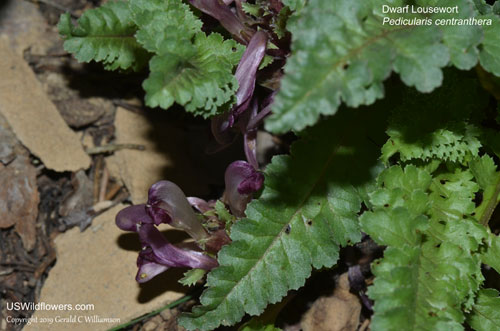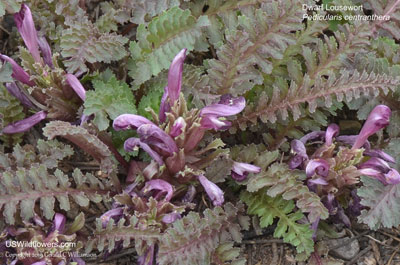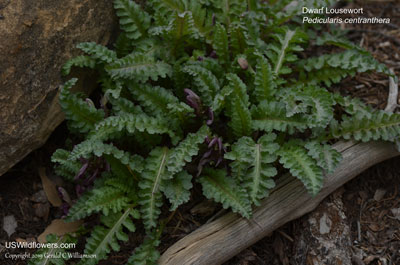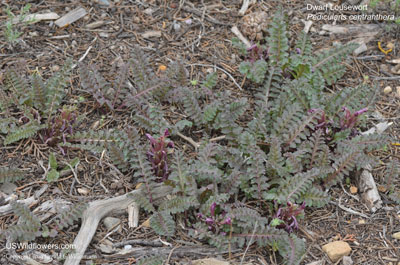Dwarf Lousewort, Spring Lousewort, Great Basin Lousewort, Wood Betony - Pedicularis centranthera
|
Pedicularis centranthera - Dwarf Lousewort, Spring Lousewort, Great Basin Lousewort, Wood Betony.
Pedicularis - Lousewort - is a large genus of around 600 hemiparasitic species worldwide, primarily in the temperate to arctic regions of the northern hemisphere, but also found in South America. Nearly half of the species are endemic to China, but there are about 40 species found in North America. There is at least one species found in each of the United States except Hawaii. Pedicularis and several other genera were moved from Scrophulariaceae into Orobanchaceae by the Angiosperm Phylogeny Group in the early 21st century (APG II).
The Lousewort genus common name comes from the old perception that cattle and other livestock which browsed on the plants were more susceptible to lice infestation. This may have been true, but likely not due to lice having any affinity to the plant, but because the livestock would eat Pedicularis on when most other plants were eaten to the ground, so the animals had their muzzles on the soil attempting to find fodder.
Pedicularis centranthera is a plant primarily of the southwestern United States, usually found in sagebrush habitat at elevations above 4000'. It ranges as far north as southeastern Oregon, and is also found in a single county in the northeastern part of California. The photos on this page were made in southwestern Colorado at an elevation of about 6800'.
Found in:
AZ, CA, CO, NM, NV, OR, UT | 
Distribution of Pedicularis centranthera in the United States and Canada:

Blue=Native; Grey=Introduced
Map from USDA Plants Database:
USDA, NRCS. 2017. The PLANTS Database (http://plants.usda.gov, 25 Apr 2025). National Plant Data Team, Greensboro, NC 27401-4901 USA.
Search Our Database: Enter any portion of the Scientific, Common Name, or both.
Do a general Google search of the entire site:
#ad
 Follow USWildflowers on Twitter
#ad
| | Site: Mesa Verde National Park, Montezuma County, CO Date: 2019-April-29 | Photographer: Gerald C. Williamson
Nikon D7000
Tamron SP 90MM f/2.8 AF Macro | | The inflorescence of Pedicularis centranthera has a spike-like raceme of several to many small flowers which are 1 to 2 inches long. They have a cream to pale purple corolla tube, and a darker purple hood-like upper lip. | | 
| | Site: Mesa Verde National Park, Montezuma County, CO Date: 2019-April-29 | Photographer: Gerald C Williamson
Nikon D7000 | | While the inflorescence may be partially hidden among the leaves once the leaves reach full length, the flowers are held above the leaves when they first start blooming. | | Click on the photo for a larger image

| | Site: Mesa Verde National Park, Montezuma County, CO Date: 2019-April-29 | Photographer: Gerald C Williamson
Nikon D7000 | | The white anthers, seen in several flowers in this photo, are exserted and are pointed - yielding the centranthera species epithet. | | Click on the photo for a larger image

| | Site: Mesa Verde National Park, Montezuma County, CO Date: 2019-April-29 | Photographer: Gerald C Williamson
Nikon D7000 | | The leaves of Dwarf Lousewort appear fernlike. They are basal and odd-pinnately lobed, with more than 7 lobes. The leaves are petiolate, and the petioles are usually shorter than the leaf blade. When the plant first starts flowering, the leaves are quite small, but may ultimately grow to over six inches long. | | Click on the photo for a larger image

| | Site: Mesa Verde National Park, Montezuma County, CO Date: 2019-April-29 | Photographer: Gerald C Williamson
Nikon D7000 | | Pedicularis centranthera is hemiparasitic - while it has chlorophyll and produces its own food, it also gleans some nutrients and water from the roots of other plants. This may have the effect of suppressing some competing plants in their vicinity. | | Click on the photo for a larger image

|
References used for identification and information:
|
|
| |
| #ad
|
|







